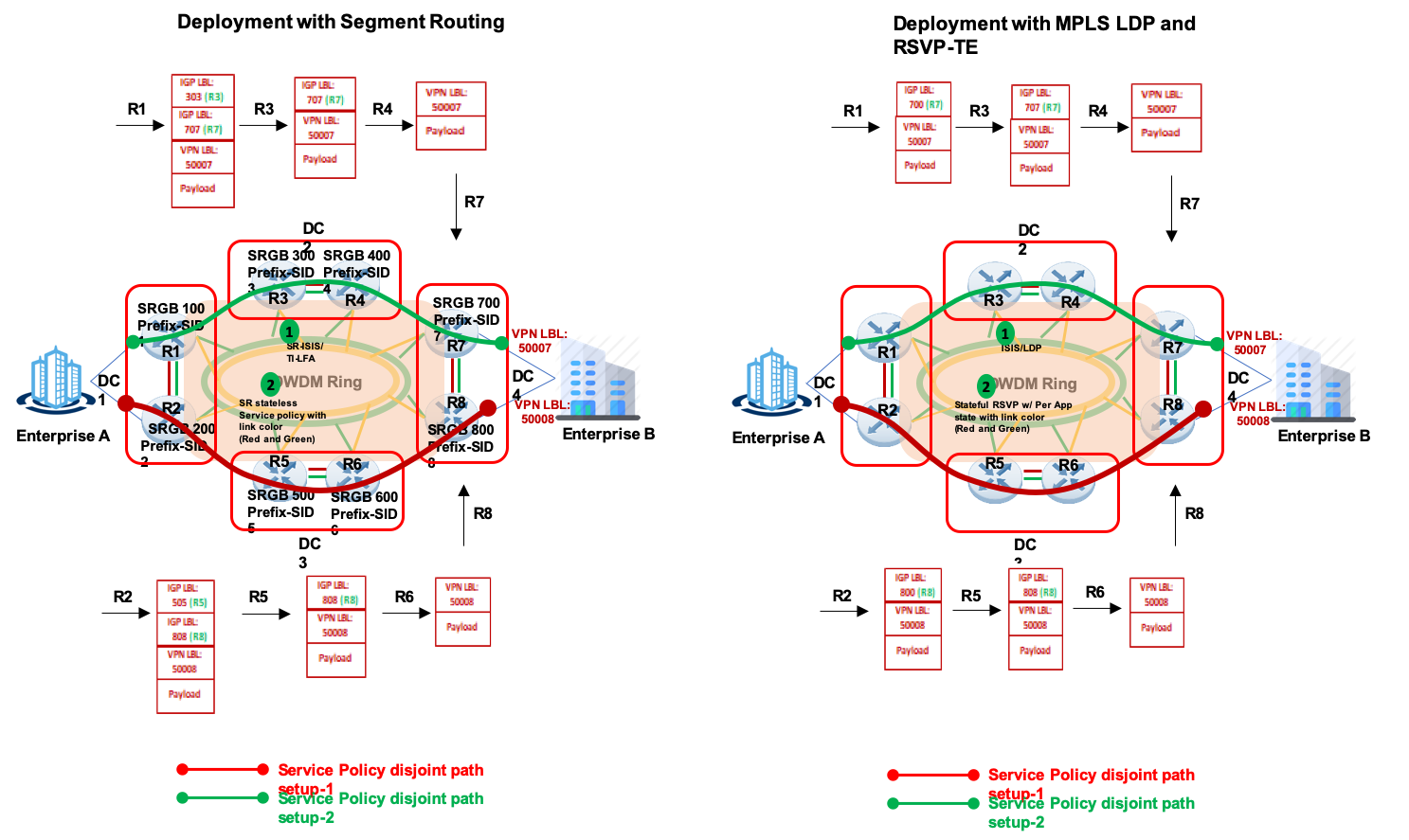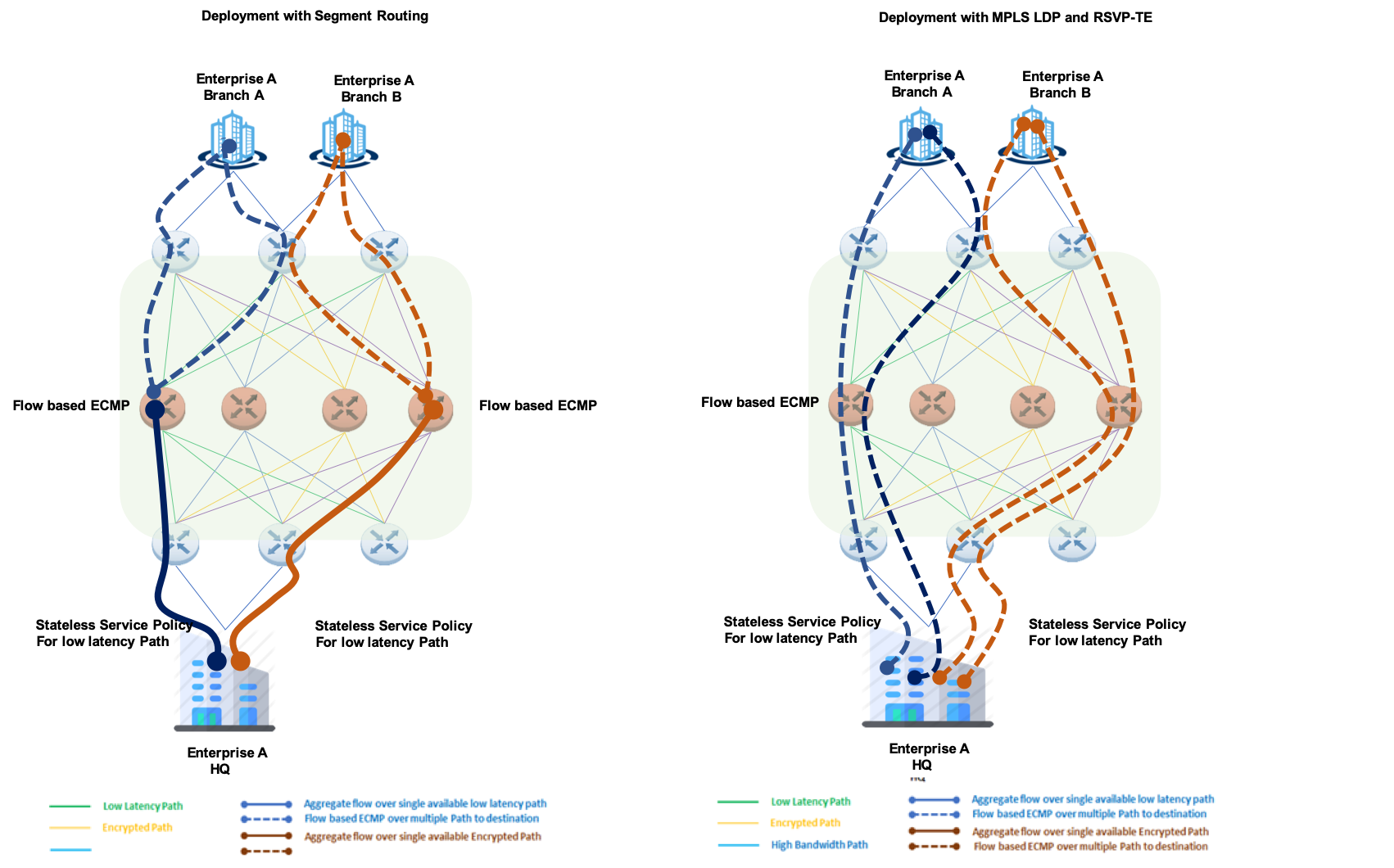Guest Author: Muhammad Durrani
Leading Global Network Architecture and Engineering
Equinix
Segment Routing 101
Segment Routing (SR) is a flexible and scalable way of performing source routing. The source chooses a path and encodes it in the packet header as an ordered list of segments.
Each segment is identified by the segment ID (SID) consisting of a flat 32-bit integer as illustrated in figure-1 below:
- Use case#1: single SID – 16050 – on R1 head-end to reach out to R5 as a loose path
- Use case#2 illustrates mix of loose and strict path to reach out to R5. The label stack on R1 can be interpreted to take shortest loose path to R4 (16040) and take strict path to R5

Segment routing eliminates the need to maintain per-application and per-flow state in the network. Instead, it decodes the forwarding instructions provided in the packet header and forwards the packet accordingly.
Segment routing supports both MPLS (Multiprotocol Label Switching) and IPv6 data plane. It natively integrates with MPLS multi service capabilities, including Layer 2 & Layer 3 VPN (L3VPN), Virtual Private Wire Service (VPWS), Virtual Private LAN Service (VPLS), and Ethernet VPN (EVPN).
Why is Equinix adopting Segment Routing?
Segment routing offers stateless service policies which simplify network and provides fine-grained control over applications for guaranteeing stringent SLAs to meet customer mission critical application requirements. It provides native tools built into the technology DNA for simplified service creation which enhances end-user experience. Faster response time via automated service creation can be delivered with the additional ability to custom fit transport to application needs which is critically important for new evolving technology adoption. It also provides built-in network resiliency with tens of millisecond convergence across any network topology.
Moreover, Segment Routing utilizes the network bandwidth more effectively than traditional MPLS networks and offers lower latency.
In summary, Segment Routing drives the next level of network simplification – at the control and data plane level – enabling operators to implement complex use cases without the need to implement and operate complex traffic engineering techniques such as MPLS RSVP TE. It significantly contributes to reducing both CapEx and OpEx.
What are the benefits for Equinix customers?
The future of networking is moving towards “Intent based networking”. Segment Routing is a foundational building block to make network infrastructures intent ready as a SDN controller can translate application intent into a Segment Routing stateless service policy that can be dynamically instantiated to carve out a virtually isolated path based on specific application requirements.
As the world’s global data center interconnection leader, Equinix is constantly innovating on behalf of its customers to help them grow their businesses. At the core of the Equinix interconnection value proposition is a global network infrastructure that offers multiple network services to both Service Providers and Enterprises alike. To offer new and differentiated value-added services and to provide a second-to-none customer experience, Equinix is implementing Segment Routing in their next-generation network infrastructure
Use case 1 – Offering legacy TDM services over a packet switching network Infrastructure
This use case includes migration of TDM services or offering new low-cost TDM services over a packet-based network. From an end-user perspective, there should not be any differences between traditional and packet-based TDM services. User should be able to subscribe to protected and unprotected services as currently being offered with traditional TDM services.
Segment routing technology with TI-LFA support brings inherent link and node protection with 50ms convergence without a need to enable complex protocols. Segment routing being packet optimized will utilize equal cost path towards the destination without any additional operational overheads and stateless service policies will minimize control plane states with complete control in operators hands on how to define the service.
Service requirement and design decisions

Implementing TDM services over a packet-based transport network with segment routing stateless traffic-engineered service policy eliminates the need to deploy complex state full RSVP-TE control plane which requires more CPU and memory resources to maintain per service policy soft states (hop by hop path and reservation messages) on every networking device along the path. It is also hard to debug complete OSI stack from layer 1 to layer 7 in production network compared to layer 1 to 3 stack in segment routing implementation.
Use case 2 – Offering Application SLA based Path selection
5G roll-out will drive significant investment in the network infrastructure to support new requirements such as network slicing – specific slices include encrypted, low latency and high bandwidth slices. It will allow Service Providers to offer new, differentiated services and create new revenue streams.
The network infrastructure should be able to offer such complex services without the need to implement complex technologies to ease day to day operational overhead.
Flexible Algorithm makes Segment routing traffic engineering even more agile. On top of current TE capabilities – stateless service policies, on-demand policy generation and automated steering -Flexible Algorithm enables multiple optimizations of the same physical network infrastructure along various dimensions called slices – for instance, slice 1 can be optimized for encrypted, slice-2 can be optimized for low-latency and slice 3 can be optimized for high bandwidth along with disjoint paths via two distinct planes using anycast capabilities. Application to slice mappings can be done using stateless service policies.
Service requirements and Design decisions

Figure 3 compares network slicing across legacy MPLS traffic engineered and emerging segment routing technology. Two obvious differences clearly stand out:
- Segment routing being packet optimized compared to RSVP-TE being circuit optimized, will inherently use ECMP path without the need to create separate policies for every possible ECMP path along the way to destination – which makes provisioning tool development and troubleshooting more simple resulting into OpEx savings.
- Better use of bandwidth across the network with simple configuration can help reduce CapEx for the price/bps on expensive network equipment.
The inherent difference between the two technologies is provisioning simplicity and optimal use of network resources which in turn simplifies network operations, topology, and visibility and troubleshooting with reduced CAPEX and OPEX.
Segment Routing is here to stay as upcoming 5G services will drive the need for low latency, highly-resilient, and bandwidth hungry differentiated services over a single physical infrastructure to meet application SLAs. To speed up 5G services’ adoption, Service Providers need to carefully choose technologies that can enable customers to provision differentiated services in real time and at scale. Segment Routing is undoubtedly one of these technologies.



CONNECT WITH US